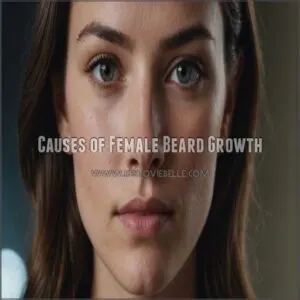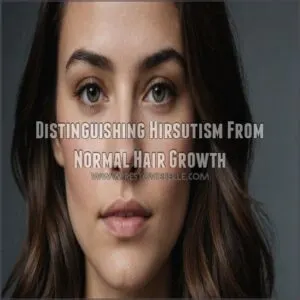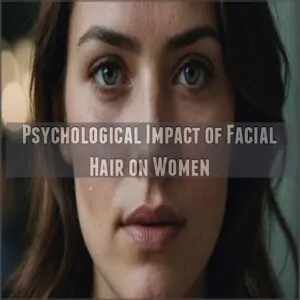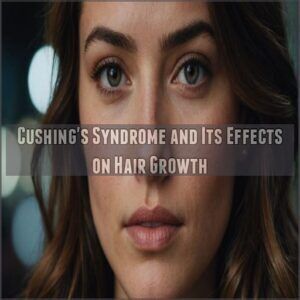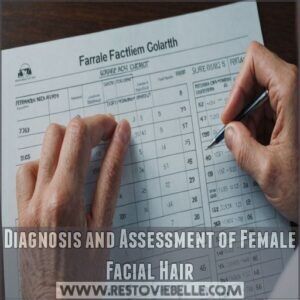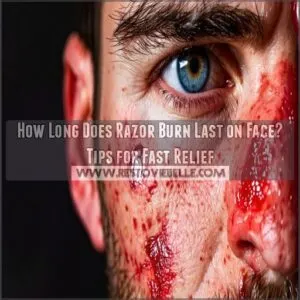This site is supported by our readers. We may earn a commission, at no cost to you, if you purchase through links.
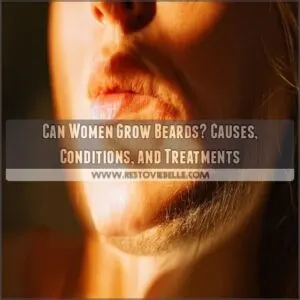 Yes, women can grow beards, though it’s not as common as in men.
Yes, women can grow beards, though it’s not as common as in men.
This condition, known as hirsutism, often springs from hormonal imbalances, like elevated androgens.
Picture it as your body flipping the "facial hair" switch to high.
Genetics can play their part, too, so blame or thank your ancestors.
Medications or conditions like Polycystic Ovary Syndrome (PCOS) and adrenal disorders might also contribute.
Managing this isn’t just about razors and creams; exploring treatments like hormone therapy can help.
Each beard story is unique, much like storytelling around campfires.
Ready to explore hair-raising tales of causes and cures?
Table Of Contents
- Key Takeaways
- Causes of Female Beard Growth
- Understanding Hirsutism
- Medical Conditions Causing Female Beard Growth
- Diagnosis and Assessment of Female Facial Hair
- Managing and Treating Female Beard Growth
- Hair Removal Options for Women
- Embracing Self-Acceptance and Seeking Help
- Frequently Asked Questions (FAQs)
- Can I grow facial hair as a woman?
- How rare is it for a woman to grow a beard?
- What causes beard growth in females?
- Will a woman grow a beard if she shaves her face?
- Can diet impact facial hair growth?
- Are supplements effective in reducing hair growth?
- What lifestyle changes can help reduce facial hair?
- Can stress influence the growth of facial hair?
- How common is facial hair in women globally?
- Conclusion
Key Takeaways
- Women can grow beards due to hormonal imbalances, genetics, or conditions like PCOS; these factors tweak your body’s natural balance.
- Managing facial hair involves hormonal treatments and lifestyle changes, but it is important to consult with healthcare professionals for personalized advice.
- Hair removal methods like laser therapy, waxing, and dermaplaning offer varied solutions for managing unwanted facial hair.
- Embracing self-acceptance while seeking professional guidance can help you confidently explore and manage facial hair growth.
Causes of Female Beard Growth
When you notice some unexpected facial hair sprouting, you might wonder about its origins, ranging from hormonal imbalances, like those seen in polycystic ovary syndrome, to just being a genetic hallmark passed down through generations.
Environmental factors, diet, and even certain medications can all play a role, turning what could be an occasional encounter with tweezers into a regular event.
Hormonal Imbalances and Their Effects
Hormonal imbalances can throw your body’s hair growth into a whirlwind.
Imagine this: you’re juggling menopause effects and nutrient deficiencies while thyroid issues sneak up on you.
Here’s what can happen:
- Stress’s impact turns a bad hair day into a regular thing.
- Hormonal therapy becomes your new best friend.
- Thyroid issues can play hide-and-seek with your confidence.
Genetic Predisposition to Facial Hair in Women
You’ve inherited your mom’s impeccable taste in sweaters, but did you also get her knack for sprouting chin hairs?
Family history plays a big role in facial hair patterns among women.
Ethnicity often adds another layer, as some genes make hair growth more prominent.
Thanks to gene mapping and DNA testing, you might just uncover the mysterious roots of your chin surprises!
Environmental and Lifestyle Factors
While genetics play a role, your environment and lifestyle also matter.
Stress can wreak havoc on your hormones, impacting hair growth.
A poor diet lacking essential nutrients won’t help either.
Getting enough sleep is key, as is minimizing exposure to pollution.
Think of your body as a finely tuned machine; treat it well, and it’ll respond in kind.
These factors can influence facial hair, so pay attention to them!
Medications and Their Role in Hair Growth
Ever wonder why some medications seem to trigger unwanted hair growth?
Sometimes, drugs like certain steroids, anticonvulsants, or even hair loss treatments can flip the switch on your hair follicles.
These side effects might puzzle you, but knowing they’re common can help.
If this happens, consult your doctor for treatment options before tapering off.
Embrace the journey!
Understanding Hirsutism
When you suddenly notice coarse, dark hair sprouting where it doesn’t belong, you might be facing hirsutism—a condition that can make you feel like you’ve stepped into an unwanted hair growth contest.
It’s surprisingly common and impacts a significant number of women worldwide, blending humor with frustration as it challenges traditional ideas about female beauty.
Definition and Characteristics of Hirsutism
Hirsutism is a condition where women experience thick, dark hair growth in areas typical for men, like the face.
It’s like having your body attempt an unexpected makeover!
This happens due to excess androgens, the hormones responsible for such growth.
Key hirsutism symptoms are unusual hair patterns.
Solutions range from hirsutism diagnosis to effective treatment, offering empowerment and control over your body.
Prevalence and Demographics of Hirsutism
- Hormonal Causes and Beard Growth: More common in women around puberty and menopause, with hormonal imbalances, such as those related to Genetics and Beard Growth, playing a significant role.
- Race and hirsutism: Higher in Mediterranean and South Asian women.
- Hirsutism by region: Varies by cultural norms.
- Genetic influence: Runs in families.
- Population differences: Global variance in prevalence of hirsutism.
Distinguishing Hirsutism From Normal Hair Growth
Spotting the difference between normal hair growth patterns and hirsutism can feel like untangling spaghetti.
Vellus hair is the soft stuff, barely there; terminal hairs are those rogue strands—the dark, dense disruptors.
Check where and how hair sprouts; hormone levels and family history play big roles.
Understanding these nuances helps separate everyday fuzz from hirsutism’s more noticeable growth.
Psychological Impact of Facial Hair on Women
Imagine looking in the mirror and feeling your self-esteem take a nosedive.
That slight stubble can play havoc with your mental health, turning whispers into roaring doubts.
Social stigma and body image issues often chip away at confidence.
Yet, remember: you’re not alone in this hairy tale.
Embrace your uniqueness, chat with friends, and explore ways to bolster your confidence.
Medical Conditions Causing Female Beard Growth
Sometimes, underlying medical conditions can cause increased facial hair growth.
Let’s explore some common conditions like PCOS, adrenal disorders, and Cushing’s syndrome, which can affect hormone levels and lead to unwanted beard growth.
Polycystic Ovary Syndrome (PCOS) and Facial Hair
Dealing with PCOS symptoms can feel like juggling flaming torches.
Many women with PCOS notice extra facial hair popping up.
Here’s how you tackle it:
- Diagnosis: See your doctor for confirmation.
- Treatment: Consider options like birth control or anti-androgen meds.
- Management: A balanced diet and regular exercise help tame the hormone rollercoaster.
Adrenal Gland Disorders and Hirsutism
Frequently, adrenal gland disorders can lead to hirsutism, where women notice unwanted facial hair.
The adrenal glands might produce excess androgens, those pesky hormones that ramp up hair growth.
Don’t sweat it, though. Treatment options are available, from medications to lifestyle changes.
Joining support groups can also help you navigate this hairy situation with confidence and humor, finding solutions that work for you.
Cushing’s Syndrome and Its Effects on Hair Growth
Cushing’s Syndrome affects hair growth by overproducing cortisol, leading to pesky excess hair.
Imagine the body throwing a wild party where hormones get out of hand—facial hair becomes the uninvited guest.
While the condition can shake up your confidence, treatment options like medication and lifestyle changes can help tame the hair.
Seek medical advice for personalized solutions.
Tumors and Hormone-Secreting Growths
Sometimes, pesky tumors or hormone-secreting growths rebel and cause unexpected facial hair in women.
These growths can throw hormone levels out of whack, leading to hirsutism.
Check out hirsutism tumor products for more information on managing this condition.
Here’s your simple playbook:
- Diagnosis: Get a detailed medical evaluation.
- Treatment: Explore surgical options or medical management.
- Support: Lean on friends or professionals for guidance.
Understanding empowers action; you’ve got this!
Diagnosis and Assessment of Female Facial Hair
When you’re noticing extra fuzz that seems more like a five o’clock shadow, it’s time for a thorough check-up to see what’s behind it.
From hormone testing to the Ferriman-Gallwey scoring system, doctors have several ways to assess what’s really going on, so you don’t have to worry alone.
Clinical Evaluation and Physical Examination
Understanding beard growth isn’t just about the conditions; evaluating it means taking a closer look at you during a clinical evaluation.
Doctors will examine your medical history, analyze your hair pattern, and perform a skin examination.
Here’s a quick table breaking down the process:
| Step | What’s Checked |
|---|---|
| Medical History | Family history, medications |
| Physical Exam | Hair pattern, skin assessment |
| Visual Inspection | Overall health, hair texture |
Hormone Level Testing and Blood Work
After a clinical exam, your doctor might order hormone testing and blood work.
This helps pinpoint the cause of your facial hair, similar to how hormonal imbalances, like those caused by PCOS or thyroid issues, can lead to beard thinning issues, making it essential to identify any underlying conditions.
Tests often include:
- Androgen (like testosterone).
- Thyroid function tests.
- Tests for PCOS.
These results, combined with your medical history, help create a personalized treatment plan.
Imaging Studies for Underlying Conditions
When you’re seeking answers behind female facial hair, imaging studies like ultrasound, CT scans, MRIs, and even X-rays, are your trusty detectives.
They’re the team Sherlock of medicine—digging deeper to spot hormone-secreting growths.
No monocle or deerstalker required—just modern medical marvels keeping their eyes peeled for clues, ensuring every aspect is explored.
Ferriman-Gallwey Scoring System for Hirsutism
You’ve probably seen hirsutism and wondered how it’s measured.
Enter the Ferriman-Gallwey scoring system.
Think of it as the official judge panel for your hair growth stage.
It scores body hair in nine areas, helping doctors figure out what’s normal and what’s not.
While it’s handy, don’t skip other tests for a fuller picture.
Managing and Treating Female Beard Growth
Managing female beard growth might feel like a challenging task, but understanding your options, from hormonal treatments to natural remedies, is important for finding what works best for you.
Embrace a mix of medical advice, lifestyle tweaks, and a touch of humor—after all, even superheroes have hair challenges—to tackle this confidently.
Hormonal Treatments and Birth Control Pills
Exploring hormonal treatments can be a game-changer in managing facial hair.
Birth control pills help balance hormones and reduce facial hair.
For those looking into specific products, there are many options available for birth control beard.
Consider these aspects:
- Side effects: Mood changes or weight gain
- Pill types: Combination or progestin-only
- Effectiveness: Varies by individual
- Dosage: Follow doctor’s advice
- Cost: Check with insurance
Find what’s right for you!
Hair Removal Techniques and Their Effectiveness
Hormonal treatments can be effective, but for immediate results, hair removal techniques like laser hair removal offer long-term solutions, zapping hairs away with precision.
For those who prefer DIY, waxing might sting but lasts longer, while threading is precise.
Cost-wise, at-home options cut expenses, yet remember, professional treatments often deliver more satisfying, enduring results.
Which route tickles your fancy?
Lifestyle Changes and Natural Remedies
Managing facial hair often involves lifestyle tweaks.
A balanced diet, sufficient sleep, and regular exercise can make a difference.
Stress reduction is key; find what helps you unwind.
While hormonal imbalances can contribute to excess hair growth, adopting a healthy lifestyle can help manage this issue.
Prioritize a nutritious diet rich in vitamins and minerals.
Aim for 7-8 hours of quality sleep nightly.
Incorporate regular exercise into your routine.
Explore stress-management techniques like yoga or meditation.
Hair Removal Options for Women
You’re not alone if those pesky facial hairs have you reaching for tweezers each morning—thankfully, there are several effective hair removal options.
From electrolysis and laser therapy to good old waxing and threading, you can choose the method that suits your needs and lifestyle.
Electrolysis and Its Effectiveness
Electrolysis might sound like a superhero power, but it’s the only FDA-approved permanent hair removal method.
It’s like having a precise, tiny zapper targeting each unwanted hair.
Compared to laser hair removal, it’s often pricier but offers lasting results.
Here’s a handy table to help you grasp the key differences:
| Aspect | Electrolysis | Laser Hair Removal |
|---|---|---|
| Cost | Higher | Lower |
| Pain Level | Moderate | Varies |
| Long-term Result | Yes | Sometimes |
| Success Rates | High | Varied |
| FDA Approved | Yes | No |
Engage your inner superhero and consider your best-fit option!
Laser Therapy for Permanent Hair Removal
Thinking about zapping those pesky hairs away for good?
Laser therapy offers a shot at permanent hair removal.
It’s a win for those tired of frequent shaving.
Costs vary, and you might face a few side effects like redness.
Best for folks with light skin and dark hair, the procedure can show results after several sessions.
It’s a bright idea!
Waxing and Threading for Temporary Hair Removal
You’ve explored laser options, but let’s talk about good ol’ waxing and threading.
Waxing strips away hair like a magic carpet ride, while threading weaves out each strand.
Pain levels? Let’s say you’ll make a funny face.
Best handled at a salon, but DIY is possible.
Consider your skin’s sensitivity and decide what’s right for you!
Dermaplaning and Other Exfoliating Methods
Waxing not your thing? Dermaplaning might be up your alley! This gentle exfoliation technique removes peach fuzz and dead skin, leaving you smooth as a baby’s bottom.
Consider:
- Dermaplaning benefits: Softens skin, boosts glow.
- Exfoliation types: Chemical, physical—choose wisely!
- Skin irritation alert: Patch test first.
- Professional vs DIY: Home kits save bucks, pros bring precision.
Try to dodge the cheese graters!
Embracing Self-Acceptance and Seeking Help
When life’s curveballs include an unexpected beard, it’s important to balance self-acceptance with seeking professional help for guidance.
You mightn’t end up with a wizardly beard, but with an expert’s advice, you’ll find the confidence to embrace your natural self and explore the best treatment options suited to your needs.
Building Confidence and Self-Esteem
Unwanted facial hair can be a real downer, impacting your body image.
You can explore various options for managing it, such as products for Facial hair removal.
But remember, you’re not alone!
Self-love starts with accepting yourself, flaws and all.
Find support – online groups or social media communities can be great.
Therapy can help you process feelings around body image.
Remember, it’s okay to not be okay, and seeking help is a sign of strength, not weakness.
Seeking Professional Help From a Dermatologist
When it feels like unwanted facial hair has taken up permanent residence, seeking professional help from a dermatologist is a smart move.
They offer guidance that’s more reliable than a GPS.
You’ll get:
- Insight into skin concerns
- Effective treatment options
- Personalized hair removal plans
- A boost in confidence
- Expertise to tackle stubborn growth
It’s like having your own beauty coach!
Open Communication With Healthcare Providers
Sure, it might feel awkward at first, but talking openly with your healthcare providers can work wonders in understanding and treating your condition.
When you’re honest, you build trust, ensuring they’re aware of your concerns.
Ask questions freely, and share your worries—like having a mini heart-to-heart about your hair-heartaches!
| Concerns | Questions | Comfort |
|---|---|---|
| Will it worsen? | Is it linked? | Am I alone? |
| Treatment options | Possible causes | Finding support |
Finding The Right Treatment Options for Individual Needs
Your skin’s as unique as your fingerprint, and finding the right hair removal method requires personalized treatments.
Maybe you’ll explore different combinations, like lifestyle adjustments or cost-effective techniques.
Picture tweaking everyday habits to find long-term solutions.
Don’t rush—it’s not a race!
Your best bet? Consult experts to discover tailor-made approaches, revealing the confidence you truly deserve.
Frequently Asked Questions (FAQs)
Can I grow facial hair as a woman?
Think of hormones as the master painters of your body’s canvas.
Yes, women can grow facial hair due to genetics or conditions like PCOS.
Managing androgen levels and consulting a dermatologist help determine treatment options.
How rare is it for a woman to grow a beard?
It’s not common, but definitely not unheard of! Hormonal imbalances or genetics can cause some women to grow beards, though it’s less frequent than in men.
What causes beard growth in females?
Sometimes, life’s little curveballs include a bit of unexpected fuzz.
Female beard growth often stems from hormonal imbalances.
These imbalances can be caused by polycystic ovary syndrome (PCOS), genetics, medications, or health conditions.
All of these factors tweak the natural balance in your system.
Will a woman grow a beard if she shaves her face?
Shaving your face won’t make you grow a beard.
Facial hair regrowth might feel coarser due to blunted ends, but the act of shaving doesn’t affect thickness or growth rate.
Hair changes often stem from hormonal factors.
Can diet impact facial hair growth?
Imagine discovering a secret about your diet—can what you eat really affect facial hair?
A diet lacking in B vitamins might encourage unwanted hair growth.
So, deliciously nutritious foods may play a role in managing it.
Are supplements effective in reducing hair growth?
While supplements like vitamin D or zinc might support overall health, they don’t directly reduce hair growth.
Addressing hormonal imbalances through diet or medication has a stronger effect, but consult a doctor for personalized advice.
What lifestyle changes can help reduce facial hair?
Tame that prickly beast by eating healthy, exercising to balance hormones, managing stress, and staying hydrated.
These changes won’t wield a magic wand but can help slow facial hair growth.
Consult a pro for personalized advice!
Can stress influence the growth of facial hair?
Stress can indeed influence facial hair growth in women by affecting hormone levels, particularly androgens.
This hormonal shift might stimulate hair follicles, potentially leading to increased facial hair.
So, managing stress is vital for overall hormonal balance.
How common is facial hair in women globally?
Facial hair’s prevalence varies widely among women globally, influenced by genetics and hormones.
Some women have barely noticeable hair, while others experience more significant growth.
It’s a spectrum, not a binary.
Conclusion
Think of female beard growth as a garden, where some plants unexpectedly thrive.
Women can grow beards due to factors like hormones, genetics, and certain medical conditions such as PCOS.
Understanding hirsutism helps distinguish this from normal hair growth, while exploring treatment options like hormonal therapy or hair removal methods offers a path forward.
Embrace self-acceptance and consult healthcare professionals to tailor the right solution for you.
Remember, every journey is unique and manageable.

